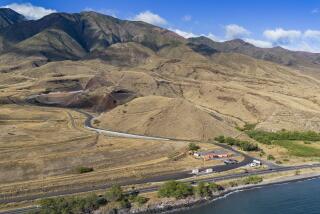Kilauea’s neighbors bask in living at the whim of nature
- Share via
KALAPANA, HAWAII — As fiery lava pours down Kilauea volcano toward Jean Olson’s lonely wooden house, incinerating everything in its path, there’s no place she’d rather be.
“Why would I live here if I didn’t like it? I have the best view of anyone in town,” said Olson, who lives about a mile from fountains of glowing lava spewing into the ocean. “Either she comes or she doesn’t. If she comes, we’ll pick up and leave.”
Thousands of visitors a day come to nearby Hawaii Volcanoes National Park to watch Kilauea erupt, something it has been doing for a quarter of a century. But some residents live with the boiling lava every day and revel in the notion that their homes and lives are subject to the whims of Earth’s awesome subterranean forces.
The danger has become clearer in recent weeks. This month, a two-block-wide swath of lava burned through abandoned homes and reached the ocean. And the first gas explosion at Kilauea’s peak since 1924 scattered gravel onto a tourist lookout, road and trail before daybreak, injuring no one but spreading fear.
Olson and her scattered neighbors have built houses atop blasted land of hardened black crust where previous neighborhoods were destroyed by lava flows in 1990. Most get their power from solar panels, their water from the rain and some of their food from gardens planted between lava rocks. Until a new lava viewing area began drawing big crowds a few weeks ago, they lived in relative isolation.
“This is heaven on Earth,” said Edmund Orian, who is building a house by hand out of lava rocks in Kalapana. “Living near a volcano keeps you aware that God is in control. If the lava comes, we can always move.”
Kilauea has not been the kind of volcano that shoots lava from its summit into the sky, causing widespread destruction for miles around.
Instead, it has been a shield volcano, or one that oozes lava from fissures in its sides, giving residents at least a few hours’ warning before it reaches their property. About 8,500 people live in the Pahoa-Kalapana area at the volcano’s base on the southeastern section of the Big Island.
In the 25 years of Kilauea’s latest eruption, lava has not directly caused any deaths, according to National Park Service rangers, though five fatalities have resulted from sightseers falling, being burned or suffering heart attacks.
Brenda Quihano saw the volcano obliterate her family’s home in 1984, but her family wants to move back if Kilauea calms down a bit. She lives in the Hawaiian Beaches neighborhood about 15 miles away, and the approaching lava doesn’t scare her.
“If you worry about something and it doesn’t happen, you look like a fool,” Quihano said as she sold water, flashlights and cameras to volcano viewers.
Lava recently destroyed four old structures in the mostly abandoned Royal Gardens subdivision, though two residents there refuse to move out. The molten rock has cut off Royal Gardens from the rest of the island.
The current flow passes within 600 feet of the new viewing area, where lava rolls toward the ocean, creating thick steam and new land.
It is difficult to forecast where the lava will go next or when the next major explosion will come, said Dave Wilson, a seismologist at Hawaiian Volcano Observatory. Significant activity probably would be preceded by hundreds of small earthquakes.
“At that point, you can say, ‘Hey, we need to get everyone out of here because this looks like something bad is going to happen,’ ” Wilson said.
When that time comes, resident Gary Smith will be ready to forsake his two-story house.
“It’s no big deal. You make peace with that when you build here,” said Smith, who moved in three years ago. “It’s amazing. People can live here and be responsible for themselves and have the government stay out of their lives.”
More to Read
Sign up for The Wild
We’ll help you find the best places to hike, bike and run, as well as the perfect silent spots for meditation and yoga.
You may occasionally receive promotional content from the Los Angeles Times.






